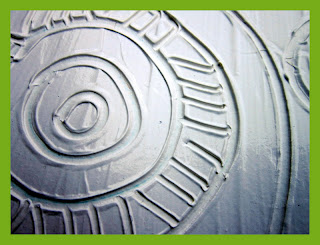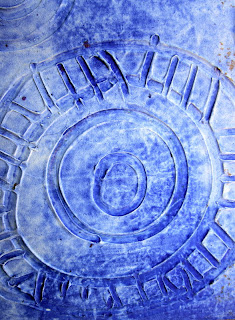Indifference is isolation. In difference is texture and wonder. ~ Edwin Schlossberg
Ever so often it's good for us to go back to basic elements of design. As artist's our work tends to start to rely heavily on one particular principle or another and we can begin to miss opportunities to experiment with techniques that can give our work, as well as our self-discovery process more depth. For example, my work relies heavily on color. So I make it part of my weekly routine to do exercises like sketching, zentangle, and others to "practice my scales."
This simple technique is so easy and a fun way to get messy! It can be done on heavy watercolor paper or regular canvas.
First, lather a good heap of gesso on your surface.
Really, get a good heaping amount on there! Keep in mind as it dries, it will shrink up just a little...
Use a spoon or palette knife to spread it out over your paper. Then go back over it with your fingers to start smoothing it out (unless of course you want these deep ruts. That's fine too! I find it easiest to go over it horizontally, then vertically, and then horizotally again. As it starts to dry, you'll lose the ability to smooth it out.
Use the tip of a thin paint brush to start carving into the gesso while it is still wet. Keep a paper towel handy to wipe off the excess. You can also use a plastic fork, palette knife, pottery carving tools, old screwdriver, or toothpicks.
The amount of detail you will want to begin painting will determine how much carving you do. If you are going to use a lot of color, writing on top, etc, then a lot of carving may be lost and you might be better off doing less. But, you can see how cool it looks just in a single color, and may want to get very detailed at this step. Either way, texture is similar to darkness and light. You don't see one without the other. If you want textured areas to stand out, make sure that you have some areas that have none. Let dry thoroughly.
Now to add some color...
This is a sample using acrylic, gesso, and a transparent watercolor. Whatever you choose to use, you'll want to make sure your paint is fairly liquidy. You'll paint it on in broad brushstrokes and then have a paper towel handy to dab off a little of the paint, taking care to leave as much paint in the crevices as possible.
For me, the acrylic was easiest to use, but it is the medium i work the most with. It did take me a few times of applying it and wiping off excess to achieve the effect I wanted.
My gesso went on pretty thck as I didnt water it down on the palette, just squeezed some directly from tube to paper. The effect is more rustic, and the streaks from the brush are apparent.
Watercolor was probably the easiest to apply and left the greatest contrast between the crevices and the rest of the paper.
At this point, you decide what you want to do next.. pen and ink, more painting with a fine brush, leaving it as is. I'm going to use some chalk pastels...
Little moments can have a feeling
and a texture that is very real.
~ Ralph Fiennes











































